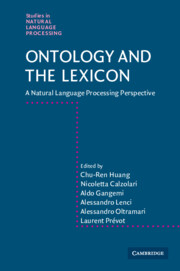Book contents
- Frontmatter
- Contents
- Contributors
- Preface
- Part I Fundamental aspects
- Part II Discovery and representation of conceptual systems
- 6 Experiments of ontology construction with Formal Concept Analysis
- 7 Ontology, lexicon, and fact repository as leveraged to interpret events of change
- 8 Hantology: conceptual system discovery based on orthographic convention
- 9 What's in a schema?
- Part III Interfacing ontologies and lexical resources
- Part IV Learning and using ontological knowledge
- References
- Index
9 - What's in a schema?
from Part II - Discovery and representation of conceptual systems
Published online by Cambridge University Press: 06 July 2010
- Frontmatter
- Contents
- Contributors
- Preface
- Part I Fundamental aspects
- Part II Discovery and representation of conceptual systems
- 6 Experiments of ontology construction with Formal Concept Analysis
- 7 Ontology, lexicon, and fact repository as leveraged to interpret events of change
- 8 Hantology: conceptual system discovery based on orthographic convention
- 9 What's in a schema?
- Part III Interfacing ontologies and lexical resources
- Part IV Learning and using ontological knowledge
- References
- Index
Summary
Introduction
This chapter presents an application of metamodelling to the ontolex interface, intended here as the set of relations (e.g. annotation, reuse, mapping, transformation, etc.) which can hold between the elements of an ontology, and the elements of a lexicon.
The c.DnS ontology (Gangemi, 2008) is here extended to formally define an Embodied Construction Grammar (ECG) (Feldman, 2006) ontology, and a semiotic façade, called Semion, which is applied to define a FrameNet (Baker et al., 1998) metamodel (OntoFrameNet) and to introduce a formal method for lexical information integration. This application is critical for the ontolex interface, because it addresses sophisticated approaches to lexicon design and linguistic theory and requires an understanding of the different notions of schema (a.k.a. frame, knowledge pattern, etc.) across domains as different as lexicon and ontology design.
In this chapter, schemata are considered as invariances that emerge from the co-evolution of organisms and environment, and that are exemplified by neurobiological, cognitive, linguistic, and social constructs. The ontologies presented here are designed according to this assumption.
While specific relations between individual ontologies and lexica are addressed in literature quite often (e.g. Gangemi et al., 2003; Buitelaar et al., 2007; De Luca et al., 2007 and several chapters in this volume), it is far less usual to propose a metamodel to formally describe the ontolex interface. Metamodels have been proposed to abridge different lexical resources, starting with OLIF (McCormick et al., 2004), and recently with reference to lexical semantics, as in LMF (Francopoulo et al., 2006), where an attempt has been made to informally align some lexica under the same metamodel.
- Type
- Chapter
- Information
- Ontology and the LexiconA Natural Language Processing Perspective, pp. 144 - 182Publisher: Cambridge University PressPrint publication year: 2010
- 8
- Cited by



